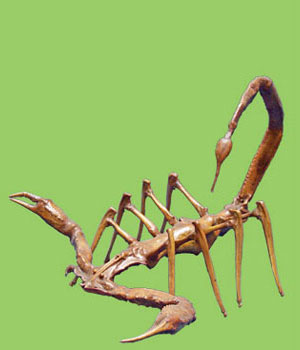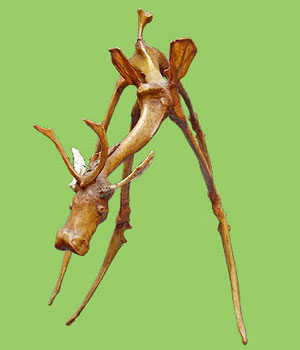 |
Taft's Sculptures | Bone Facts | Bones in Art & Religion
Gallery: Taft Richardson's Bone Sculptures |
|||
Be Alert |
|||
|
Taft Richardson uses animal bones as both his primary material for making sculpture and as his main symbol for his work's meaning. In his work, bones represent the cycle of life and death, the resurrection inherent in Christian belief, and the ways in which cast-off things can take on new use and beauty. All of these meanings cycle into each other, just the way that in nature bones cycle back into plants. It is no surprise that his home is surrounded by trees and that he teaches the children to grow plants as well as to make art -- all of these are connected with the bones that are his work's core.
Richardson is inspired by what he senses as a kind of life still in the bones, and he often talks about the parable of Ezekiel and the Valley of Dry Bones (see the section on Spirituality), whereby the Lord returned the bones to life. A favorite old African-American spiritual was turned into a familiar children's song, called "Dry Bones."
Taft's Process
Nearly forty years ago, Richardson began picking up bones as he walked along roads going from place to place. It took him a while to start making art with them.
Taft doesn't use human bones, but he uses all kinds of animal bones. He collects them from a variety of sources: from roadsides, from a farm that used to have a youth program where he volunteered, and from friends who eat meat. Richardson himself is a vegetarian, because working with the bones has given him such a strong connection with living animals.
• Watch Video: Vegetarianism
 In his enclosed back yard, Richardson thoroughly cleans and bleaches the bones. "It bothers people to see the bones," he says about his sense of privacy. After that Richardson sorts the bones onto a series of racks containing various types and sizes. Many of the bones he uses are already in fragments, and these he sorts by shape.
In his enclosed back yard, Richardson thoroughly cleans and bleaches the bones. "It bothers people to see the bones," he says about his sense of privacy. After that Richardson sorts the bones onto a series of racks containing various types and sizes. Many of the bones he uses are already in fragments, and these he sorts by shape.
Over the years, Richardson has worked on his techniques. Some of his earlier pieces are a darker tan color because originally he varnished them. In his newer work, he has left the bones their natural color. He has also developed special methods with glue. Using a combination of simple Elmer's household glue and bones that he has ground to a powder, he creates a strong bond with a suitable matte texture.
• Watch Video: Finding Animals
Bone Glue
Although the Elmer's glue that Richardson uses is made of synthetic chemicals, his use of bones mixed with that glue taps into the long history of glue made from bones and hides of animals. The Egyptians used animal collagen to make glue 4000 years ago, and glue was used in the construction of the Tomb of King Tut. But the use of glue evidently goes back even further—in 1998, scientists found that glue had been used to waterproof baskets 8000 years ago in what is now Israel.
Glue made from animal skin and bones later became commonly used for furniture building and other work with wood and paper. It is still used for restoration of antique furniture, musical instruments, and artworks. Most of the bones and hide used for restoration are remnants of the beef industry.
Watch and Pray | Go to The Fish | Stand Tall | Saving Grace | Have Faith
 |
